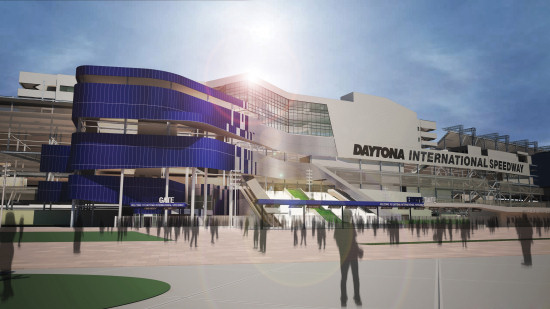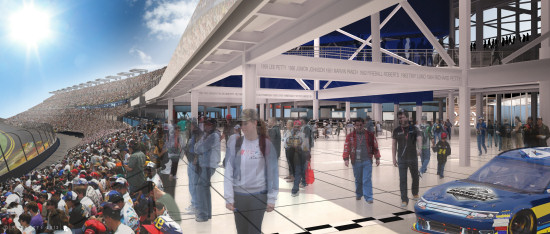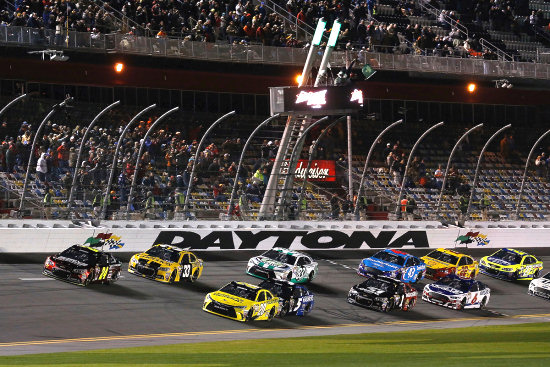Joie Chitwood on Daytona in 2016by Gordon Kirby |
 Next year's Rolex 24 Hours and Daytona 500 will witness the formal opening of a total renovation of the Daytona International Speedway. Called, 'Daytona Rising: Re-imagining an American Icon' the project will cost $400 million and will take more than two years of work.
Next year's Rolex 24 Hours and Daytona 500 will witness the formal opening of a total renovation of the Daytona International Speedway. Called, 'Daytona Rising: Re-imagining an American Icon' the project will cost $400 million and will take more than two years of work.
The new grandstand complex will feature three different concourse levels and five expanded entrances, called 'injectors', which will lead fans to a series of escalators and elevators so that they can reach their seats with a minimum of walking or stair-climbing. Seats will be reduced in number to 101,000 but they will be wider and more comfortable with easy access to more restrooms and concession stands. The entire place will also be fully wi-fied. The completed project will include 1,600 miles of data cable, more than 4,200 miles of fiber optic cable and 9,200 data network connections. There will also be 60 high-end luxury suites for corporate entertaining. At last weekend's Daytona 500 I discussed the project with DIS president Joie Chitwood. "I think as you chart your course to the future you've always got to look to your past and where you came from," Chitwood ruminated. "And if you really look at what Big Bill France did which was to start with the beach races, which were profitable and people enjoyed, but then he charted a new course.  © Daytona Int'l Speedway "Today, more than fifty years later, it's time to make another move into a new era," Chitwood went on. "We asked ourselves, what does today's fan really want? We're the 'World Center of Racing' and we wanted to take that concept to the next stage of what today's race fan and sports fan expect when they come to an event. So we decided we wanted not just to renovate the place but to rebuild it completely. "Now, that's something that's easy to say but to do it is something else again. Rebuilding the infrastructure of a place like this is a huge job. The grandstand is nine-tenths of a mile long and the scale of the job and the technology partners we needed to make all this happen is a lot bigger than a traditional football or baseball stadium. We're talking about a significantly bigger scale from all perspectives, including cost. "There are 60 million tons of concrete to support 40 million pounds of steel in the new structure. For all of us it was a daunting challenge but we have an opportunity to do something that nobody's done. If we're going to plant our flag in the ground as a new Daytona and a new standard for the sport we are going to walk in Big Bill's footsteps. "And that's what we want to do. We want to live up to his legacy and we wanted to do something big and bold, but I did not know how much effort it was going to take and the scale of everything required from all our technology partners. It's bigger than we ever thought it was going to be and that's exciting because we're living up to the brand. Nobody has done a motor sports stadium like this and when it opens next year it's going to be awesome." Chitwood explained the thinking that went into the project. "As we started developing our plans, we started asking our fans what they want," he said. "We asked our current fans what they wanted to see and they told us vertical transportation. They said we had to get them up and down the grandstands better and more efficiently. Many of them told us they were tired of walking up and down so many long stairways, and when you think about it, any new fan is already used to a much better experience at so many of the new ball fields that have been built across the country in recent years. "So we're catering to our fans who've been coming here for thirty or forty years but we're also catering to the young fans who expect much better treatment when they come to your property. The Atlanta Braves are building a new stadium in Atlanta to replace Turner Field which was opened in 1996. Turner Field is less than twenty years old and they're leaving a venue that you would think would still be current. I think that fact tells you how rapidly things are changing and that you've got to respond to new expectations.  © Mike Levitt/LAT USA "The history of this track is built on the racetrack itself. It's the same shape and location that it's always been. The start/finish line is the same today as it was when Lee Petty crossed it to win the first 500 in 1959. The banking and the turns are exactly the same and always will be. What we wanted to do was improve the amenities while enjoying the history and the heritage. This is the same track that the Pettys, Allisons and Earnhardts raced on, but we wanted to change the amenities so the older fan, the middle years fan and the younger fan all enjoy in the right way." Chitwood emphasized the roles that wi-fi and social media will play in the new-look Daytona Speedway. "In today's world people go to sports events as social events," he remarked. "They want to take photos and share them. They want to text and update. So making this an environment that's totally friendly to today's social media world was of prime importance. "Ten years ago we wouldn't even have thought of social media but today you've got to balance both the social media activity with the sporting activity. The social media aspect is a key element in the design on the new facility." Chitwood refuted the criticism that the new Speedway will be downsized by losing some 50,000 seats amid the renovation. "I've yet to hear anybody say a $400 million investment is a downsizing," he retorted. "It's the biggest investment in anything in our company's history. We built Kansas and Chicago and didn't spend anywhere near that amount of money. So that investment in and of itself is phenomenal. "All 101,000 seats will be wider and more comfortable with all the technology they need. This is the plan for the future. This is making sure we can survive and continue to excel because at the end of the day as our technology partners in the TV world continue to get better and better and bring you a better TV show it gets tougher and tougher for us track promoters to compete with everything we can provide the fan at the track.  © Daytona Int'l Speedway "I think every sports property is fighting the same battle. We want to provide an environment where everyone goes away happy and are ready to come back next year. We have to continue to invest so we can pull you off the couch and away from the great TV show that Fox and NBC can give you. We've got to keep the fans coming and attract new fans as well. "When you come to Daytona you're making an investment. You don't wake up in the morning and decide that you're driving to the track that day. You have a plan in place. You have a hotel, or a campsite. You are going to spend some money to come here. Sixty percent of our crowd comes from outside Florida. This is part of a vacation, or it's something that's on their schedule for some time and we have to make sure it stays on their schedule. So this is about the next decade and more, and what we need to do to attract fans. "When you think about where we are after fifty years. There was no master plan to develop the place and it's been added to over the years in different decades. You've got wooden seats that were great in their day but we're in a different age and we're putting our flag in the ground and our money where our mouths are." Chitwood explained the reasoning for removing the backstretch grandstands. "The backstretch is our lowest renewal and lowest conversion rate, which means converting fans from the backstretch to the frontstretch," he said. "We have a hard time getting fans to renew who come to watch from the backstretch or to convert into buying a seat on the frontstretch. We believe that's because when you're on the backstretch you're disconnected from the event. You don't get to see the pitstops or victory lane and driver introductions. "When the new frontstretch is ready with escalators, concourses and all the other elements, it will provide a completely different experience and in that environment the backstretch would be even more removed. We don't want to offer a sub-par experience. We want to focus on improving the amenities and making the right investments so the fans keep coming back. "So we will start removing those grandstands in June of this year and by November they will be gone. There will no longer be a backstretch grandstand."  © Mike Levitt/LAT USA "This is all private dollars invested and we have to be very diligent in how we spend our money," Chitwood said. "We have shareholders to report to and we have to produce return and make the numbers work. "Every step of the way from management to the board of directors to Lesa France Kennedy there's serious scrutiny of what we're doing because we're a public company. We had to walk them through why spending $400 million and making the biggest investment in Daytona's history is going to result in tangible benefits down the road. "The goal is to generate $10 million in revenue and to increase EBIDA--that's earning before interest, debt and tax depreciation--by $15 million. We're going to increase the value of the Speedway by reinvesting and rebuilding the grandstands. It also gives us a chance to have more content, the chance of promoting concerts, or soccer. You name it. This is an investment in the future and will increase the value of the company." Chitwood said he believes a seat at Daytona is a bargain in today's hyper-inflated sports world. "We have $90 tickets on the frontstretch that will go up to $95 next year," he said. "I think that's an unbelievably reasonable increase. You can sit on the frontstretch at the Daytona 500 for $95 at a time when the Superbowl has a $3,000 ticket, and you can bring your cooler in with your own food and drink and we also have free parking. I'm not aware of any other sports venue that offers those kinds of opportunities. "You cannot go to the NBA finals, or a World Series game, or the Superbowl for $95 and bring in a cooler with your own food and drink. I think we are hands down the most cost-conscious and valued player in sports today."  © Daytona Int'l Speedway "We have a legacy of Big Bill taking a risk to build a racetrack that everybody told him was impossible and it not only worked but became the biggest event on NASCAR's calendar with the biggest TV rating and the most Fortune 500 support. "We've got to live up to that legacy. We can't substandard anything and I think our team enjoys that challenge. We want to be big and bold and we're getting great response from our fans. The wow factor has been great this weekend and when we open in 2016 I think it will be off the charts." Sad to say, crowds were down substantially at Daytona last week. You could blame cold weather for the poor turn-outs for Thursday's qualifying races and Friday's truck race but Saturday's Xfinity race also drew a slim crowd amid warmer weather. Sunday brought even better weather and a pretty healthy crowd although a smattering of empty seats were evident throughout the grandstands. It will be intriguing to see therefore how fans react next year to the new-look Daytona Speedway and how successful Chitwood's vision will be in the longterm. |
|
Auto Racing ~ Gordon Kirby
Copyright ~ All Rights Reserved |
